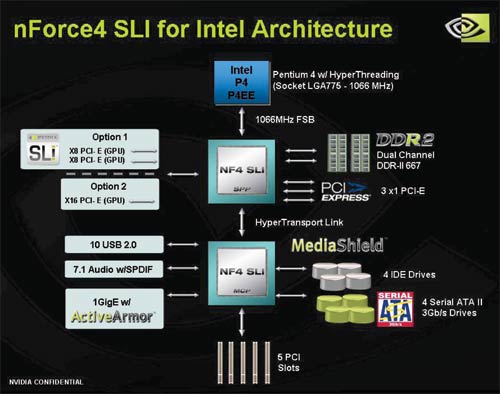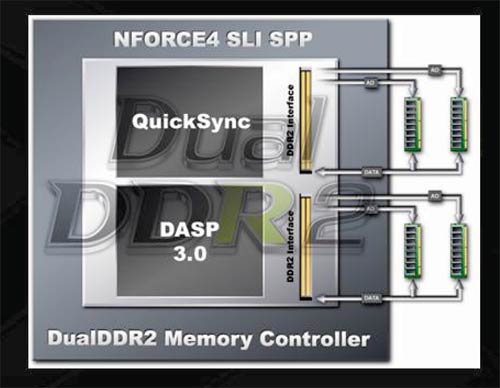Dual Core Intel Platform Shootout - NVIDIA nForce4 vs. Intel 955X
by Anand Lal Shimpi on April 14, 2005 1:01 PM EST- Posted in
- CPUs
NVIDIA's nForce4 SLI Intel Edition Chipset
As we've indicated in the past, NVIDIA's first Intel chipset is very similar to their nForce4 AMD chipset, with a couple of exceptions. For starters, the Intel Edition chipset is made up of two chips, compared to the AMD chipset's one. The reasoning is simple: with AMD's architecture, NVIDIA needn't include a memory controller in their chipset, which cuts down on overall die size quite a bit. With the Intel Edition, we see the first new memory controller that NVIDIA has introduced since nForce2.

Remember DASP? NVIDIA's Dynamic Adaptive Speculative Pre-Processor is back in nForce4 Intel Edition, but this time around, the competition is much stronger. DASP is a hardware pre-fetch engine that resides within the memory controller and attempts to pre-fetch data into a small amount of cache on the chipset, which NVIDIA's algorithms determine will be used by the CPU in the future. Intel has a similar technology in their 955X chipset, although it's not something they have branded or marketed. Depending on how aggressive NVIDIA's DASP is, it could make good use of the extra memory bandwidth offered by its dual channel DDR2-533/667 memory bus.

NVIDIA also boasts a dedicated address bus per DIMM slot with the nForce4; however, this seems to be a feature also supported by Intel, so there isn't much advantage over the competition here.
In their final memory controller optimization, NVIDIA's QuickSync claims to be able to reduce memory latency when operating in multiple clock domains (e.g. 800MHz FSB, but 533MHz memory bus). Later in this article, we'll find out exactly how aggressive NVIDIA's memory controller truly is.
The nForce4 SLI Intel Edition chipset supports both 800 and 1066MHz FSBs, just like the 955X - however, NVIDIA also indicated that if Intel were to increase the FSB frequency, they would be ready.
Unlike the 955X, NVIDIA only supports 3 PCI Express x1 slots. However, NVIDIA does offer two PATA channels, compared to Intel's single PATA channel. NVIDIA also offers more USB 2.0 ports (10 vs 8). NVIDIA does not support Intel's HD Audio spec, so you're stuck with AC'97 on the nForce4 SLI.










96 Comments
View All Comments
mlittl3 - Friday, April 15, 2005 - link
Sorry one typo in that last post.I should have said, "...AMD's processors f**king rock."
:)
mlittl3 - Friday, April 15, 2005 - link
Oh and one other thing. Because Intel has such an influence on the IT industry, their constant indecision has cost us many delays in technology.Only until Intel moved to 64 bits in the last 12 months has Microsoft surprisingly come out with WinXP 64. The industry won't move unless Intel moves. And when they move everyone has to jump.
Programmers are now scrambling to optimize code for 64bits and multithreading because they can't get their 5 GHz singlethreaded 32bit Prescott anymore. AMD said it was going that way and that the rest of the IT industry needs to go to 64bits and dual cores. They said this almost two years ago when they released the K8 architecture.
No one jumped. No one changed their code. We are slaves to Intel's whims because no one will make a decision unless Intel tells them too. Innovation will always suffer at the likes of monopolies like Intel. Thankfully, AMD's processors were so superior to Intel's that the chip giant had to budge or face market share decreases.
If you think I'm a conspiracy theory crackpot, I let current events speak for themselves. Why does a 80%+ market share, $80 bill revenue per year, industry leader have to adopt any tactics from a small insignificant rival like AMD?
I tell you the answer, AMD's processors rock.
Thank you. That is all.
mlittl3 - Friday, April 15, 2005 - link
#59, #63I am not done flaming questar after his last post about roadmaps (#54).
That is the biggest Intel loving bunch of bullsh*t I have ever heard.
To keep the record straight, Intel completely tore up its roadmaps last year when it cancelled plans for its 4GHz prescott. They completely changed their entire marketing and engineering strategy. Their entire roadmap is different now.
I get so mad when people like him just see Intel's name and assumes stable roadmaps. I've been following tech for many years now, so here we go.
Fact #1. Intel promoted Megahertz=performance for years.
Fact #2. Intel recently said that megahertz isn't everything and other factors need to be considered.
180 reversal.
Fact #3. Intel said they would never use model numbers to identify processors and that AMD was misleading their customers.
Fact #4. Intel now uses model numbers to identify their processors.
180 reversal.
Fact #5. Intel was going to use the netburst architecture up to 6 GHz+.
Fact #6. Intel has cancelled any concrete plans to increase processor speed beyond 4 GHz in the immediate future.
180 reversal.
Fact #7. Intel was going to use the Pentium 4 for all laptops.
Fact #8. As I currently write this, no current Dell laptop models (Intel's largest distributor) have a pentium 4 in them.
180 reversal
Fact #9. Intel said a year ago that 64bits is not ready for many years and will not implement the technology until it is ready.
Fact #10. All currently released Intel processors except for 5xx and Pentium M use EM64T technology.
180 reversal.
Fact #11. There were no plans for dual core in Intel processors until AMD said that dual core was planned from the beginning of the K8 architecture.
Fact #12. Intels "fastests" processors are becoming dual core.
180 reversal.
Questar, exactly what 3 year roadmaps from Intel have remained unchanged? We have no idea if Intel will change on us again and go a completely different route. How do you know that the current 3 year roadmap will stay unchanged? Do you have a crystal ball? No one can foresee that far into the future in the IT industry.
3 years ago Intel showed roadmaps of the Pentium 4 to go to 6 GHz with no model numbers, no 64bits, no Pentium M, no dual core. I really need some clarification from you because I'm so confused.
And all you other loyal IT readers out there, please let me know if I left any other 180 reversal of Intel out. There have been so many it's hard to keep track.
Calin - Friday, April 15, 2005 - link
Motley, I totally agree PCI Express is good for alot of things - SCSI, iSCSI, Gigabit Ethernet, and others. However, you won't see neither one of them on the mainboards with 915, 925x or similar chipsets. Those kind of things appear on server-level chipsets, and some of them had PCI-E for quite some timeCalin - Friday, April 15, 2005 - link
"It's pretty clear - Intel's last few products have been worthless in many cases."You damn americans - just because something is not the absolute number one, it means it is worthless?
I would like to have a Northwood processor at 3.6 GHz and at the price of a Sempron 2200, but that doesnt' mean Prescott are worthless
Dennis Travis - Friday, April 15, 2005 - link
Anand, You were right to keep this test Intel since that is what the test was about anyway, Dual Core Intel on either NVIDIA or Intel boards. When the Dual Core AMD's come out, then it would be great to see a test with both platforms on the NVIDIA NF4 boards.mkruer - Friday, April 15, 2005 - link
Anand; I hope that when you get the Athlon64 X2, if you don’t have it already, you will end up doing the most comprehensive benchmarking on the planet! The full Server/Desktop/Multimedia/Games package. Testing Single Xeon, Single Opteron, Dual Xeon, Dual Opteron, Dual-Core P4 and Dual-Core Opteron. Also I would recommend against using benchmarking suites, instead use real world applications. In fact, that would be an interesting tests in it self. Does benchmarking suites really give accurate results compared to the real product?thelostjs - Friday, April 15, 2005 - link
umm overclocking comparo? <-- humble broke teenchennhui - Friday, April 15, 2005 - link
#63Pro & Con of Hyperthreading
http://www.anandtech.com/showdoc.aspx?i=1746&p...
KeithDust2000 - Friday, April 15, 2005 - link
JoKeRr, "And if we look ahead, Intel is making dualcore 65nm's thermal evenlope same as Northwood at 89W (don't count on me though), I'm impressed b/c Intel is actively addressing the problems."They were responsible for the problems in the first place, and the only reason they are addressing them is that they now have some competition that would gain a lot of market share if they continued to ignore the interests of their customers going forward. If there´s something admirable about that, I must have missed it.